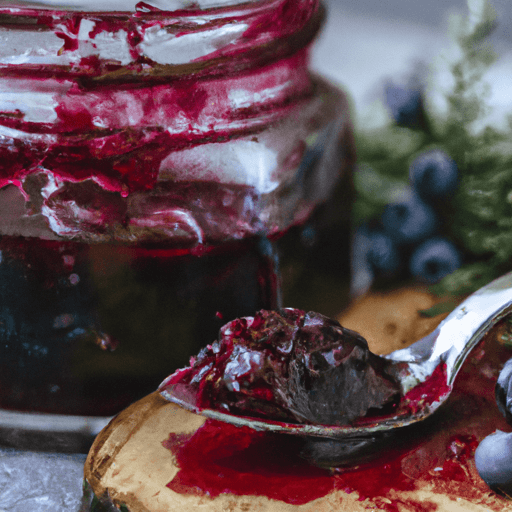The Sweet and Tangy Delight: Blueberry Jam
Blueberry jam is a versatile and mouthwatering spread that has captured the hearts of food enthusiasts around the world. Bursting with the flavor of fresh blueberries, this delectable preserve is a perfect accompaniment to a variety of dishes and a delightful treat on its own. In this blog post, we’ll dive into the sumptuous taste, common uses in cooking, nutritional value, and uncover some interesting history and facts about blueberry jam.
The Taste of Blueberry Jam
Blueberry jam is known for its distinctive taste that combines sweetness with a subtle tang. The delightful burst of flavor comes from the natural sugars present in blueberries, enhanced by the preservation process. When you spread it on your toast or spoon it onto your pancakes, you’ll experience the concentrated essence of fresh blueberries, creating a symphony of sweet and tangy notes that dance on your taste buds.
Versatility in the Kitchen
Blueberry jam is more than just a delicious spread. It can elevate your culinary creations to new heights. Its versatility in the kitchen opens up a world of possibilities. Here are just a few ways you can incorporate blueberry jam into your favorite recipes:
Toast and Pastries: Blueberry jam pairs perfectly with toast, bagels, croissants, and other pastries. Spread a generous amount on warm bread for a delightful breakfast treat or use it as a filling for homemade danishes and turnovers.
Desserts: Whether you’re making a cheesecake, tart, or trifle, blueberry jam adds a burst of flavor and a touch of elegance to your sweet creations. Swirl it into your cake batter or layer it between buttery cookies to create a mouthwatering dessert.
Sauces and Glazes: Blueberry jam makes a fantastic base for sauces and glazes. Use it as a marinade for grilled meats, a topping for roasted vegetables, or a glaze for baked goods. Its sweet and tangy profile adds depth and complexity to a wide range of dishes.
Nutritional Value
Not only is blueberry jam a delicious treat, but it also offers several nutritional benefits. Blueberries are packed with antioxidants that help protect the body against harmful free radicals. Additionally, they are a rich source of vitamins, minerals, and dietary fiber. When transformed into jam, blueberries retain some of their nutritional value, making it a guilt-free indulgence. However, it’s important to remember that blueberry jam contains added sugars and should be enjoyed in moderation.
History and Fun Facts
Blueberries have been enjoyed for centuries, and their transformation into jam is a relatively recent culinary innovation. Here are a few interesting facts about blueberry jam:
Native Americans were the first to have a taste of blueberries. They used to dry and preserve them for winter months when fresh food was scarce.
The production of blueberry jam on a larger scale began in the late 19th century. Canned blueberry jam became widely available during World War II when fresh produce was rationed.
Did you know? July is National Blueberry Month in the United States, celebrating the abundance and versatility of this delicious fruit.
Blueberries are one of the few fruits native to North America. This fact makes blueberry jam not only a culinary delight but also a symbol of local produce and heritage.
Conclusion
Blueberry jam is a delightful spread that adds a burst of flavor to countless dishes. Its sweet and tangy taste, versatility in the kitchen, and nutritional value make it a must-have pantry staple. Whether you enjoy it on toast, as a dessert component, or as a sauce base, blueberry jam is sure to elevate your culinary creations. So go ahead, indulge in this mouthwatering delight and experience the magic of blueberries in every bite.
Blueberry Jam
Origin: Blueberry jam is believed to have originated in North America, where blueberries are native. Native Americans were known to make a type of blueberry preserves by cooking blueberries with honey or maple syrup. Early settlers continued this tradition and blueberry jam became popular across the country.
Common Uses: Blueberry jam is commonly used as a spread for toast, bagels, and biscuits. It can also be used as a filling for pastries, tarts, and cakes. Blueberry jam is often a key ingredient in desserts like pies and crumbles. It can even be used as a glaze for meats, such as pork or poultry, to add a touch of sweetness.
Nutritional Benefits: Blueberries, the main ingredient in blueberry jam, are known for their high antioxidant content. They are also a good source of dietary fiber, vitamin C, and vitamin K. Blueberries are low in calories and fat, making them a healthy choice. However, it’s important to note that jam is typically high in sugar, so it’s best consumed in moderation.
Unique Properties: Blueberries contain natural pectin, a substance that helps jams and jellies thicken. This makes blueberries ideal for making jams without the need for additional pectin. The deep purple color of blueberry jam is not only visually appealing but also indicates the presence of anthocyanins, which are powerful antioxidants.
Historical Significance: Blueberries have been used by Native Americans for centuries for their medicinal properties. They were believed to improve digestion and boost the immune system. Blueberry jam played a role in American history when it was mentioned in the Civil War song, “Maryland, My Maryland,” which referred to blueberry jam as a symbol of Southern hospitality. Today, blueberry jam is a popular staple in households worldwide.




Use the share button below if you liked it.
It makes me smile, when I see it.